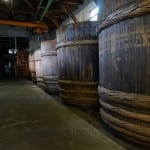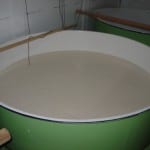 There are many things that determine how good a batch of sake will be. And there are equally as many opinions about each and every one of those things. Factors that some brewers consider indispensable or key, others will downplay or even outright contradict – if not diss – with opposite philosophies. Depending on your threshold for vagueness, it can either be frustrating or fascinating.
There are many things that determine how good a batch of sake will be. And there are equally as many opinions about each and every one of those things. Factors that some brewers consider indispensable or key, others will downplay or even outright contradict – if not diss – with opposite philosophies. Depending on your threshold for vagueness, it can either be frustrating or fascinating.
One of these factors is the size of the batch, or the “shikomi,” measured in kilos of rice that went into a given tank to create that batch of sake.
Perhaps typical is a ton to a ton-and-a-half (a metric ton, mind you, so 1000 kg or 2200 pounds) of the combination of the rice and koji (the rice that has had koji mold propagated upon it). But there are those of the opinion that much smaller shikomi, say 600 kg or so, are infinitely better for super premium sake.
Perhaps the smallest size I have seen is 500kg on a practical level, although smaller sizes exist as well. But done at this scale, yields are quite low. And brewers need to ask themselves, from an economical point of view, is it worth it in the end? When considering the time required to do each of the many steps, then have it take up tank space, press it and filter it when fermentation is complete, bottle it and care for it and more – it would be so much more economical to double, triple or quadruple your yields for true efficiency. And many, many breweries function at those larger economies of scale.
Naturally, though, at some point, the law of diminishing returns kicks in with a vicious vengeance and quality begins to noticeably suffer. But just where that occurs, and how each toji (master brewer) feels about it, varies hugely.
For example, some do not think that smaller is always better, citing the truth that it is much harder to  control parameters such as temperature in those smaller tanks over the long run. To achieve a given flavor and aromatic profile, brewers guide the moromi (fermenting mash) along a very tight temperature curve. Smaller batches are more subject to various factors that might send them out of spec, so to speak.
control parameters such as temperature in those smaller tanks over the long run. To achieve a given flavor and aromatic profile, brewers guide the moromi (fermenting mash) along a very tight temperature curve. Smaller batches are more subject to various factors that might send them out of spec, so to speak.
Conversely, a largish tank would lumber along so much more heavily that wild swings in temperature would not likely happen. But of course the counterpunch to this is that if your temperature and other parameters stray from the fold of the ideal, it is easy to bring them back into alignment with small batches, back to where you want them to be, whereas in big batches the sheer mass makes it harder to forcibly change the temperature once it has strayed.
But again: there are various philosophies. One hugely famous toji of almost unmatched accomplishment insists that larger batches of about 1.5 tons are ideal. He also insists on slightly customizing his tank dimensions, because by doing so the moromi mixes itself and he does not have to mess with using long poles to mix it up. It all occurs naturally in his kura as, inside the tanks, carbon dioxide bubbles stick to dissolving rice particles and the countless yeast cells, rising to the top, where the gas is released and the now-dense glob sinks again. And if your shikomi size is right, it all circulates perfectly, around and around and around…
One fact worth mentioning, however, is that almost always the more premium grades of sake are indeed made in comparatively smaller batches, at least compared to the shikomi size of the lower grades of sake for that brewer. And contest sake, too, is almost without exception made in smaller batches. But this surely arises from the aforementioned ability to tightly control key parameters.
Lately I have come across this information on the back labels of some sake bottles: they actually tell us the size of the shikomi.
Now what in the world are we supposed to do with this information? In the end, the flavors and aromas of a sake before us are either appealing, or they are not. Biasing our minds with such information before tasting will but encumber our enjoyment by unnecessarily prejudicing it.
 But as always, there are a myriad of opinions. One big gun of a distributor in the Tokyo/Yokohama metropolis insists that a sake has to be made in a batch that is 600 kg or smaller to be decent. He cites his ten-year convincing effort focused on one famous kura to lower their shikomi size from a ton to 600 kg, and when they did, they won a major international award. True, the smaller shikomi size might have had something to do with it, but so might a gazillion other things. But hey, what do I know.
But as always, there are a myriad of opinions. One big gun of a distributor in the Tokyo/Yokohama metropolis insists that a sake has to be made in a batch that is 600 kg or smaller to be decent. He cites his ten-year convincing effort focused on one famous kura to lower their shikomi size from a ton to 600 kg, and when they did, they won a major international award. True, the smaller shikomi size might have had something to do with it, but so might a gazillion other things. But hey, what do I know.
So enjoy your sake for its flavors and aromas. And should you come across the shikomi size, now you know its significance, and its potential liabilities.
~~~~~~~~~~~~~~~~~~~~~~~~~~~~~~~~~~~
 Interested in Sake? Pick up a copy of my latest book, Sake Confidential, A Beyond-the-Basics Guide to Understanding, Tasting, Selection, and Enjoyment.
Interested in Sake? Pick up a copy of my latest book, Sake Confidential, A Beyond-the-Basics Guide to Understanding, Tasting, Selection, and Enjoyment.
Learn more here.




